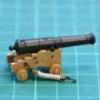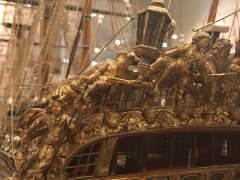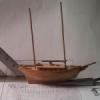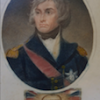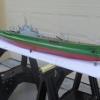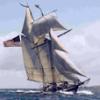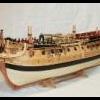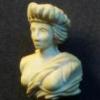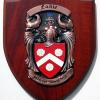Supplies of the Ship Modeler's Handbook are running out. Get your copy NOW before they are gone! Click on photo to order.
×
-
Posts
610 -
Joined
-
Last visited
Reputation Activity
-
 Remcohe reacted to Piet in Muscongus Bay Lobster Smack by Piet - FINISHED - Midwest Products - length 15"
Remcohe reacted to Piet in Muscongus Bay Lobster Smack by Piet - FINISHED - Midwest Products - length 15"
Yesterday was an okay day. I took that pesky display board inside the house Thursday evening and yesterday morning the stain and poly had cured just fine. It came out nice and smooth, like velvet.
I also cemented the centerboard to the keel last Thursday and cemented the trail boards to the bow. I decided to just paint a simple design on them using gold paint. They don't look bad at all this way.
So, yesterday, Friday, I could finally mount the little sloop to the display stand. I did make bamboo pins to help secure the sloop to the posts and used Titebond glue. Everything worked great. I could now attach the boom holding rope as Dee_Dee suggests. I did raise the boom somewhat to allow some slack in that rope so the boom can swing. I am leaving the parrels on it for my convenience in rigging and fastening the sail.
I also moved the lanyard cleats a little higher on the mast because they may get hooked into the boom fork.
So, it looks like I'm ready for the sails and that's another can of worms.
Here is the boom to mast detail in how my hold down rope looks. It's not completely finished yet but yuns get the idea.
This shows that hold down rope. It may allow the boom to lift up more then we really want but so be it. As you can see i have temporarily tied the boom up a little. The boom will be lower when the sail is attached. That little eyebolt on top of the boom is to tie the sail lacing cord to.
Cheers,
-
 Remcohe reacted to tlevine in HMS Atalanta 1775 by tlevine - FINISHED - 1:48 scale - from TFFM plans
Remcohe reacted to tlevine in HMS Atalanta 1775 by tlevine - FINISHED - 1:48 scale - from TFFM plans
Thanks, Tom. And thank you everyone for the likes. Remco, I will just have to keep your mantra in mind as I attempt the metal work..."Treat each part as if it is a model on its own, you will finish more models in a day than others do in a lifetime". Michael, the space is difficult to photograph because of all the reflections but when I am home and there is some sun I will give it a try. Cannot use flash because of the mirrors.
-
 Remcohe got a reaction from daHeld73 in HMS Bellona 1760 by SJSoane - Scale 1:64 - English 74-gun - as designed
Remcohe got a reaction from daHeld73 in HMS Bellona 1760 by SJSoane - Scale 1:64 - English 74-gun - as designed
I'd shape it off the model too.
Remco
Re. CA, don't
-
 Remcohe got a reaction from cog in HMS Kingfisher 1770 by Remcohe - 1/48 - English 14-Gun Sloop - POF
Remcohe got a reaction from cog in HMS Kingfisher 1770 by Remcohe - 1/48 - English 14-Gun Sloop - POF
Thanks all for the kind comments and likes!
Tony, I stopped using minwax because it does not give a dead flat finish unless you sand it a little after applying. Not very practical in hard to reach spots. I really look for a flat finish and a finish that will bond the last traces of sanding dust as well (with boxwood you'll have very fine white dust accumulating in the wood grain). So after some experimenting with different finishes this is what I found out until now.
Beeswax diluted with white spirit, it corrodes the brass and coper nails in the model
Micro crystalline wax diluted with white spirit, no corrosion but traces of sanding dust remain visible
Sanding sealer, nice flat finish but traces of sanding dust remain visible
With Tungoil diluted with white spirit (50%) I have the best results, nearly a flat finish and all the sanding dust takes the color of the wood.
Druxey, I saw that one coming who knows, if I can find some decent reference material I'll give it a shot.
Greg, dry bending with hot air (the admirals hair dryer is a fine tool in the shipwright)
Piet, no need to bring tools, you can use mine to examine the Kingfisher. Everything except for the magazine is still very visible with my optivisor. Once the upper deck goes in that will change. But no worries, no way I will be that far when you get here :-)
Remco
-
 Remcohe got a reaction from tlevine in HMS Kingfisher 1770 by Remcohe - 1/48 - English 14-Gun Sloop - POF
Remcohe got a reaction from tlevine in HMS Kingfisher 1770 by Remcohe - 1/48 - English 14-Gun Sloop - POF
Thanks all for the kind comments and likes!
Tony, I stopped using minwax because it does not give a dead flat finish unless you sand it a little after applying. Not very practical in hard to reach spots. I really look for a flat finish and a finish that will bond the last traces of sanding dust as well (with boxwood you'll have very fine white dust accumulating in the wood grain). So after some experimenting with different finishes this is what I found out until now.
Beeswax diluted with white spirit, it corrodes the brass and coper nails in the model
Micro crystalline wax diluted with white spirit, no corrosion but traces of sanding dust remain visible
Sanding sealer, nice flat finish but traces of sanding dust remain visible
With Tungoil diluted with white spirit (50%) I have the best results, nearly a flat finish and all the sanding dust takes the color of the wood.
Druxey, I saw that one coming who knows, if I can find some decent reference material I'll give it a shot.
Greg, dry bending with hot air (the admirals hair dryer is a fine tool in the shipwright)
Piet, no need to bring tools, you can use mine to examine the Kingfisher. Everything except for the magazine is still very visible with my optivisor. Once the upper deck goes in that will change. But no worries, no way I will be that far when you get here :-)
Remco
-
 Remcohe got a reaction from alangr4 in HMS Kingfisher 1770 by Remcohe - 1/48 - English 14-Gun Sloop - POF
Remcohe got a reaction from alangr4 in HMS Kingfisher 1770 by Remcohe - 1/48 - English 14-Gun Sloop - POF
Thanks all for the kind comments and likes!
Tony, I stopped using minwax because it does not give a dead flat finish unless you sand it a little after applying. Not very practical in hard to reach spots. I really look for a flat finish and a finish that will bond the last traces of sanding dust as well (with boxwood you'll have very fine white dust accumulating in the wood grain). So after some experimenting with different finishes this is what I found out until now.
Beeswax diluted with white spirit, it corrodes the brass and coper nails in the model
Micro crystalline wax diluted with white spirit, no corrosion but traces of sanding dust remain visible
Sanding sealer, nice flat finish but traces of sanding dust remain visible
With Tungoil diluted with white spirit (50%) I have the best results, nearly a flat finish and all the sanding dust takes the color of the wood.
Druxey, I saw that one coming who knows, if I can find some decent reference material I'll give it a shot.
Greg, dry bending with hot air (the admirals hair dryer is a fine tool in the shipwright)
Piet, no need to bring tools, you can use mine to examine the Kingfisher. Everything except for the magazine is still very visible with my optivisor. Once the upper deck goes in that will change. But no worries, no way I will be that far when you get here :-)
Remco
-
 Remcohe got a reaction from Piet in HMS Kingfisher 1770 by Remcohe - 1/48 - English 14-Gun Sloop - POF
Remcohe got a reaction from Piet in HMS Kingfisher 1770 by Remcohe - 1/48 - English 14-Gun Sloop - POF
Thanks all for the kind comments and likes!
Tony, I stopped using minwax because it does not give a dead flat finish unless you sand it a little after applying. Not very practical in hard to reach spots. I really look for a flat finish and a finish that will bond the last traces of sanding dust as well (with boxwood you'll have very fine white dust accumulating in the wood grain). So after some experimenting with different finishes this is what I found out until now.
Beeswax diluted with white spirit, it corrodes the brass and coper nails in the model
Micro crystalline wax diluted with white spirit, no corrosion but traces of sanding dust remain visible
Sanding sealer, nice flat finish but traces of sanding dust remain visible
With Tungoil diluted with white spirit (50%) I have the best results, nearly a flat finish and all the sanding dust takes the color of the wood.
Druxey, I saw that one coming who knows, if I can find some decent reference material I'll give it a shot.
Greg, dry bending with hot air (the admirals hair dryer is a fine tool in the shipwright)
Piet, no need to bring tools, you can use mine to examine the Kingfisher. Everything except for the magazine is still very visible with my optivisor. Once the upper deck goes in that will change. But no worries, no way I will be that far when you get here :-)
Remco
-
 Remcohe got a reaction from Elmer Cornish in HMS Kingfisher 1770 by Remcohe - 1/48 - English 14-Gun Sloop - POF
Remcohe got a reaction from Elmer Cornish in HMS Kingfisher 1770 by Remcohe - 1/48 - English 14-Gun Sloop - POF
Thanks all for your very kind compliments and likes!
So time to get back inside the hull. All beams were cut to size previously and here they are test fitted with all the lower deck details temporary in place. I'm not too pleased how the upper well discolored overtime. In the beginning I have used minwax and it made the wood a bit greenish. I also need to check the dimensions of the louvers as they look a bit thick to my eye compared to the other details. Ah well I'll just make an other one in due time.
Before I proceed to install the carlings and ledges I made the hammock battens, al bit of mass production as there are quite a few to be made of different sizes. Preliminary shape (the last bit is in front of the pile af battens) was made on the table saw and then the battens were cut to size and further refined using files and sandpaper. The drilling and installing of the tiny bolts (0,3 mm) took some time. The last step was to bend the longer battens to conform with the curving of the deck beams. The outer bolts will be installed when the battens are fixed permanently in place and will help to pin the battens to the deck beams.
Port side has been done starboard side is still in the clamping jig ...
Remco
-
 Remcohe got a reaction from Rustyj in HMS Kingfisher 1770 by Remcohe - 1/48 - English 14-Gun Sloop - POF
Remcohe got a reaction from Rustyj in HMS Kingfisher 1770 by Remcohe - 1/48 - English 14-Gun Sloop - POF
Thanks all for the kind comments and likes!
Tony, I stopped using minwax because it does not give a dead flat finish unless you sand it a little after applying. Not very practical in hard to reach spots. I really look for a flat finish and a finish that will bond the last traces of sanding dust as well (with boxwood you'll have very fine white dust accumulating in the wood grain). So after some experimenting with different finishes this is what I found out until now.
Beeswax diluted with white spirit, it corrodes the brass and coper nails in the model
Micro crystalline wax diluted with white spirit, no corrosion but traces of sanding dust remain visible
Sanding sealer, nice flat finish but traces of sanding dust remain visible
With Tungoil diluted with white spirit (50%) I have the best results, nearly a flat finish and all the sanding dust takes the color of the wood.
Druxey, I saw that one coming who knows, if I can find some decent reference material I'll give it a shot.
Greg, dry bending with hot air (the admirals hair dryer is a fine tool in the shipwright)
Piet, no need to bring tools, you can use mine to examine the Kingfisher. Everything except for the magazine is still very visible with my optivisor. Once the upper deck goes in that will change. But no worries, no way I will be that far when you get here :-)
Remco
-
 Remcohe got a reaction from archjofo in HMS Kingfisher 1770 by Remcohe - 1/48 - English 14-Gun Sloop - POF
Remcohe got a reaction from archjofo in HMS Kingfisher 1770 by Remcohe - 1/48 - English 14-Gun Sloop - POF
Thanks all for your very kind compliments and likes!
So time to get back inside the hull. All beams were cut to size previously and here they are test fitted with all the lower deck details temporary in place. I'm not too pleased how the upper well discolored overtime. In the beginning I have used minwax and it made the wood a bit greenish. I also need to check the dimensions of the louvers as they look a bit thick to my eye compared to the other details. Ah well I'll just make an other one in due time.
Before I proceed to install the carlings and ledges I made the hammock battens, al bit of mass production as there are quite a few to be made of different sizes. Preliminary shape (the last bit is in front of the pile af battens) was made on the table saw and then the battens were cut to size and further refined using files and sandpaper. The drilling and installing of the tiny bolts (0,3 mm) took some time. The last step was to bend the longer battens to conform with the curving of the deck beams. The outer bolts will be installed when the battens are fixed permanently in place and will help to pin the battens to the deck beams.
Port side has been done starboard side is still in the clamping jig ...
Remco
-
 Remcohe got a reaction from SailorGreg in HMS Kingfisher 1770 by Remcohe - 1/48 - English 14-Gun Sloop - POF
Remcohe got a reaction from SailorGreg in HMS Kingfisher 1770 by Remcohe - 1/48 - English 14-Gun Sloop - POF
Thanks all for your very kind compliments and likes!
So time to get back inside the hull. All beams were cut to size previously and here they are test fitted with all the lower deck details temporary in place. I'm not too pleased how the upper well discolored overtime. In the beginning I have used minwax and it made the wood a bit greenish. I also need to check the dimensions of the louvers as they look a bit thick to my eye compared to the other details. Ah well I'll just make an other one in due time.
Before I proceed to install the carlings and ledges I made the hammock battens, al bit of mass production as there are quite a few to be made of different sizes. Preliminary shape (the last bit is in front of the pile af battens) was made on the table saw and then the battens were cut to size and further refined using files and sandpaper. The drilling and installing of the tiny bolts (0,3 mm) took some time. The last step was to bend the longer battens to conform with the curving of the deck beams. The outer bolts will be installed when the battens are fixed permanently in place and will help to pin the battens to the deck beams.
Port side has been done starboard side is still in the clamping jig ...
Remco
-
 Remcohe got a reaction from Elmer Cornish in HMS Kingfisher 1770 by Remcohe - 1/48 - English 14-Gun Sloop - POF
Remcohe got a reaction from Elmer Cornish in HMS Kingfisher 1770 by Remcohe - 1/48 - English 14-Gun Sloop - POF
Thanks all.
David B, well the thing is I'm building Admiralty style so as I'm not adding any more planking it looks like the straps are underneath the planking. But if you look closer you can see small shims I used to compensate for the lack of planking on the lower two gudgeons.
Remco
-
 Remcohe got a reaction from michael mott in HMS Kingfisher 1770 by Remcohe - 1/48 - English 14-Gun Sloop - POF
Remcohe got a reaction from michael mott in HMS Kingfisher 1770 by Remcohe - 1/48 - English 14-Gun Sloop - POF
Thanks all for the kind comments and likes!
Tony, I stopped using minwax because it does not give a dead flat finish unless you sand it a little after applying. Not very practical in hard to reach spots. I really look for a flat finish and a finish that will bond the last traces of sanding dust as well (with boxwood you'll have very fine white dust accumulating in the wood grain). So after some experimenting with different finishes this is what I found out until now.
Beeswax diluted with white spirit, it corrodes the brass and coper nails in the model
Micro crystalline wax diluted with white spirit, no corrosion but traces of sanding dust remain visible
Sanding sealer, nice flat finish but traces of sanding dust remain visible
With Tungoil diluted with white spirit (50%) I have the best results, nearly a flat finish and all the sanding dust takes the color of the wood.
Druxey, I saw that one coming who knows, if I can find some decent reference material I'll give it a shot.
Greg, dry bending with hot air (the admirals hair dryer is a fine tool in the shipwright)
Piet, no need to bring tools, you can use mine to examine the Kingfisher. Everything except for the magazine is still very visible with my optivisor. Once the upper deck goes in that will change. But no worries, no way I will be that far when you get here :-)
Remco
-
 Remcohe got a reaction from GLakie in Young America 1853 by EdT - FINISHED - extreme clipper
Remcohe got a reaction from GLakie in Young America 1853 by EdT - FINISHED - extreme clipper
Nice to see the master at work, you make it look so easy.
Remco
-
 Remcohe reacted to archjofo in La Créole 1827 by archjofo - Scale 1/48 - French corvette
Remcohe reacted to archjofo in La Créole 1827 by archjofo - Scale 1/48 - French corvette
Thank you all.
I´m very pleased by yours nice words.
Your comments give me more flavor in the works and I will try to do the best possible result.
Here's a little update of my report.
Look yourself ...
-
 Remcohe reacted to Gaetan Bordeleau in Le Fleuron by Gaetan Bordeleau - FINISHED - 1:24
Remcohe reacted to Gaetan Bordeleau in Le Fleuron by Gaetan Bordeleau - FINISHED - 1:24
The next parts will be under the balcony.
General height to work on a table is 30 inches. To work, especially on small parts, 30 inches is far from being ideal height, it is often too low; easy solution; adjustable height table, electric or by hand or even at lower price in the used. If I would have known before this is the kind of tool I would have bought a lot sooner.
-
 Remcohe reacted to tlevine in HMS Atalanta 1775 by tlevine - FINISHED - 1:48 scale - from TFFM plans
Remcohe reacted to tlevine in HMS Atalanta 1775 by tlevine - FINISHED - 1:48 scale - from TFFM plans
The bearding line was drawn on the fore edge of the rudder and cut in with a chisel. The advantage of the 4-part rudder blade is apparent here. The junction between the port and starboard halves of the rudder make an easily followed line. The width of the bearding is narrower at the bottom and gradually increases towards the top of the rudder. The bearding stops below the mortise for the tiller.
The rudder was positioned and the locations for the gudgeons were marked out. The recesses for the pintles were drawn and then cut out, leaving a little extra wood for final positioning later.
The width of the rudder is the same thickness as the stern post and tapers top to bottom. I took measurements off the sternpost and drew them into the pintle recesses for easy reference. The taper was sanded. I had taken the sole plate off earlier but have temporarily replaced it so one can see the amount of wood removed.
Next comes cutting the mortise for the tiller and then the dreaded metalwork.
-
 Remcohe reacted to newbuilder101 in San Felipe by newbuilder101 (Sherry) – Scale 1:96
Remcohe reacted to newbuilder101 in San Felipe by newbuilder101 (Sherry) – Scale 1:96
Thank-you everyone for the well wishes! My eye is healing quite nicely.
I've put together a very basic mini tutorial and hope it may be of help to someone.
I bought a brass turned cannon, of the correct scale for my ship, to use as a reference model.
I had a piece of round plastic dowel on hand, which I carved and sanded until it was the same size as the reference model.
Next, I cut paper trapezoids and rolled them around the plastic dowel, and sealed with some white glue. The dowel ensured that all my cannons would be the same.
Next up, I marked the location for each ring, by comparing to the reference model and cut very thin strips of paper and glued them in place. This can be tricky since the paper tube is narrow at one end and the strip naturally wants to spiral up the tube.
The cascabels/miniature mushrooms , were fashioned from polymer clay, then baked and glued in place. I had tried carving them from a wood dowel, but decided that clay would be a faster option.
At this point the "bore" was added. I dipped a toothpick in white glue and applied a thin film around the inside of the end of the cannon. Once dry I repeated once or twice more as needed.
This picture is a repeat from my last update, but it gives a good idea of the different stages.
Finally, a couple of thin layers of flat black acrylic were added and allowed to dry, followed by dry-brushing with yellow-ochre that was tamed down with a little brown.
This last picture shows the finished paper cannon beside the original brass cannon, which I also painted.
If you have any questions, please feel free to ask.
-
 Remcohe reacted to EdT in Young America 1853 by EdT - FINISHED - extreme clipper
Remcohe reacted to EdT in Young America 1853 by EdT - FINISHED - extreme clipper
Young America - extreme clipper 1853
Part 107 – Lower Hull Work
I finally finished the hull planking this week and got some other tasks well along. The first picture shows the full extent of the planking on the port side – as yet unpainted..
The deck is still masked for painting the white inside bulwarks. That work is now also finished and the installation of the painted waterways can proceed.
The next picture shows some of the seemingly endless task of treenailing the planking.
This work, too, is now complete on both sides of the hull. The picture also shows work on the rudder gudgeons. These were made by first silver soldering a tube into a groove in a sheet of .032” brass. The rough gudgeons were then ripped off on the circular saw as shown below.
The .032” brass – about 2 ½” at 1:72 – is too thick for the straps, but allowed the thick area at the hinge to be shaped. The 6” wide straps were then bent and filed back to about 1” thick. The next picture shows the bottom four installed using small brass nails.
The 16” aft face or the stern post is notched to receive the 6” wide gudgeons. These were aligned when being fitted by a stiff, straight rod through the holes. The end of the rod will mark the final center of the round helm opening – which must be on the hinge centerline.
The next picture shows the gudgeons on the starboard side.
The top one will be installed after this side is painted. Some of the lowest rows of “yellow metal” sheathing have been installed around the gudgeon. This will be the only gudgeon requiring this, since this is the lowest of the planking at the stern. The top of sheathing line – parallel and slightly above the load waterline - can be seen in this picture. There will be several rows of sheathing. The top row will be on the straight, horizontal sheathing line. The strakes below will follow the planking shear and “gore” into this top strake.
The brass plates were cut from .002” brass. The nailing pattern was embossed into the plates used an embossing device. The picture below shows the nail pattern being drilled in a wood block to make this.
The thickness of the block was sized carefully to allow small steel nails to be inserted from the underside. The tips protrude just enough to impart the pattern when stamped as shown below.
Stamping these plates is almost as thrilling as treenailing. Fortunately there are only about a half-dozen rows. A close up of the first few stamped plates is shown in the last photo.
After the pine stamping block “breaks in” the dimples become more regular. These are like little cheese graters. They are fastened with contact cement – another enjoyable task. After making and installing 3700 of these my Victory model, I swore I wouldn’t do this again – but that was in 1978.
Ed
-
 Remcohe got a reaction from mtaylor in HMS Kingfisher 1770 by Remcohe - 1/48 - English 14-Gun Sloop - POF
Remcohe got a reaction from mtaylor in HMS Kingfisher 1770 by Remcohe - 1/48 - English 14-Gun Sloop - POF
Thanks all for the kind comments and likes!
Tony, I stopped using minwax because it does not give a dead flat finish unless you sand it a little after applying. Not very practical in hard to reach spots. I really look for a flat finish and a finish that will bond the last traces of sanding dust as well (with boxwood you'll have very fine white dust accumulating in the wood grain). So after some experimenting with different finishes this is what I found out until now.
Beeswax diluted with white spirit, it corrodes the brass and coper nails in the model
Micro crystalline wax diluted with white spirit, no corrosion but traces of sanding dust remain visible
Sanding sealer, nice flat finish but traces of sanding dust remain visible
With Tungoil diluted with white spirit (50%) I have the best results, nearly a flat finish and all the sanding dust takes the color of the wood.
Druxey, I saw that one coming who knows, if I can find some decent reference material I'll give it a shot.
Greg, dry bending with hot air (the admirals hair dryer is a fine tool in the shipwright)
Piet, no need to bring tools, you can use mine to examine the Kingfisher. Everything except for the magazine is still very visible with my optivisor. Once the upper deck goes in that will change. But no worries, no way I will be that far when you get here :-)
Remco
-
 Remcohe got a reaction from druxey in HMS Kingfisher 1770 by Remcohe - 1/48 - English 14-Gun Sloop - POF
Remcohe got a reaction from druxey in HMS Kingfisher 1770 by Remcohe - 1/48 - English 14-Gun Sloop - POF
Thanks all for the kind comments and likes!
Tony, I stopped using minwax because it does not give a dead flat finish unless you sand it a little after applying. Not very practical in hard to reach spots. I really look for a flat finish and a finish that will bond the last traces of sanding dust as well (with boxwood you'll have very fine white dust accumulating in the wood grain). So after some experimenting with different finishes this is what I found out until now.
Beeswax diluted with white spirit, it corrodes the brass and coper nails in the model
Micro crystalline wax diluted with white spirit, no corrosion but traces of sanding dust remain visible
Sanding sealer, nice flat finish but traces of sanding dust remain visible
With Tungoil diluted with white spirit (50%) I have the best results, nearly a flat finish and all the sanding dust takes the color of the wood.
Druxey, I saw that one coming who knows, if I can find some decent reference material I'll give it a shot.
Greg, dry bending with hot air (the admirals hair dryer is a fine tool in the shipwright)
Piet, no need to bring tools, you can use mine to examine the Kingfisher. Everything except for the magazine is still very visible with my optivisor. Once the upper deck goes in that will change. But no worries, no way I will be that far when you get here :-)
Remco
-
 Remcohe got a reaction from giampieroricci in HMS Kingfisher 1770 by Remcohe - 1/48 - English 14-Gun Sloop - POF
Remcohe got a reaction from giampieroricci in HMS Kingfisher 1770 by Remcohe - 1/48 - English 14-Gun Sloop - POF
Thanks all for your very kind compliments and likes!
So time to get back inside the hull. All beams were cut to size previously and here they are test fitted with all the lower deck details temporary in place. I'm not too pleased how the upper well discolored overtime. In the beginning I have used minwax and it made the wood a bit greenish. I also need to check the dimensions of the louvers as they look a bit thick to my eye compared to the other details. Ah well I'll just make an other one in due time.
Before I proceed to install the carlings and ledges I made the hammock battens, al bit of mass production as there are quite a few to be made of different sizes. Preliminary shape (the last bit is in front of the pile af battens) was made on the table saw and then the battens were cut to size and further refined using files and sandpaper. The drilling and installing of the tiny bolts (0,3 mm) took some time. The last step was to bend the longer battens to conform with the curving of the deck beams. The outer bolts will be installed when the battens are fixed permanently in place and will help to pin the battens to the deck beams.
Port side has been done starboard side is still in the clamping jig ...
Remco
-
 Remcohe got a reaction from IgorSky in HMS Kingfisher 1770 by Remcohe - 1/48 - English 14-Gun Sloop - POF
Remcohe got a reaction from IgorSky in HMS Kingfisher 1770 by Remcohe - 1/48 - English 14-Gun Sloop - POF
Thanks all for your very kind compliments and likes!
So time to get back inside the hull. All beams were cut to size previously and here they are test fitted with all the lower deck details temporary in place. I'm not too pleased how the upper well discolored overtime. In the beginning I have used minwax and it made the wood a bit greenish. I also need to check the dimensions of the louvers as they look a bit thick to my eye compared to the other details. Ah well I'll just make an other one in due time.
Before I proceed to install the carlings and ledges I made the hammock battens, al bit of mass production as there are quite a few to be made of different sizes. Preliminary shape (the last bit is in front of the pile af battens) was made on the table saw and then the battens were cut to size and further refined using files and sandpaper. The drilling and installing of the tiny bolts (0,3 mm) took some time. The last step was to bend the longer battens to conform with the curving of the deck beams. The outer bolts will be installed when the battens are fixed permanently in place and will help to pin the battens to the deck beams.
Port side has been done starboard side is still in the clamping jig ...
Remco
-
 Remcohe got a reaction from Geoff Matson in HMS Kingfisher 1770 by Remcohe - 1/48 - English 14-Gun Sloop - POF
Remcohe got a reaction from Geoff Matson in HMS Kingfisher 1770 by Remcohe - 1/48 - English 14-Gun Sloop - POF
Thanks all.
David B, well the thing is I'm building Admiralty style so as I'm not adding any more planking it looks like the straps are underneath the planking. But if you look closer you can see small shims I used to compensate for the lack of planking on the lower two gudgeons.
Remco
-
 Remcohe got a reaction from Vivian Galad in HMS Kingfisher 1770 by Remcohe - 1/48 - English 14-Gun Sloop - POF
Remcohe got a reaction from Vivian Galad in HMS Kingfisher 1770 by Remcohe - 1/48 - English 14-Gun Sloop - POF
Thanks all for your very kind compliments and likes!
So time to get back inside the hull. All beams were cut to size previously and here they are test fitted with all the lower deck details temporary in place. I'm not too pleased how the upper well discolored overtime. In the beginning I have used minwax and it made the wood a bit greenish. I also need to check the dimensions of the louvers as they look a bit thick to my eye compared to the other details. Ah well I'll just make an other one in due time.
Before I proceed to install the carlings and ledges I made the hammock battens, al bit of mass production as there are quite a few to be made of different sizes. Preliminary shape (the last bit is in front of the pile af battens) was made on the table saw and then the battens were cut to size and further refined using files and sandpaper. The drilling and installing of the tiny bolts (0,3 mm) took some time. The last step was to bend the longer battens to conform with the curving of the deck beams. The outer bolts will be installed when the battens are fixed permanently in place and will help to pin the battens to the deck beams.
Port side has been done starboard side is still in the clamping jig ...
Remco


